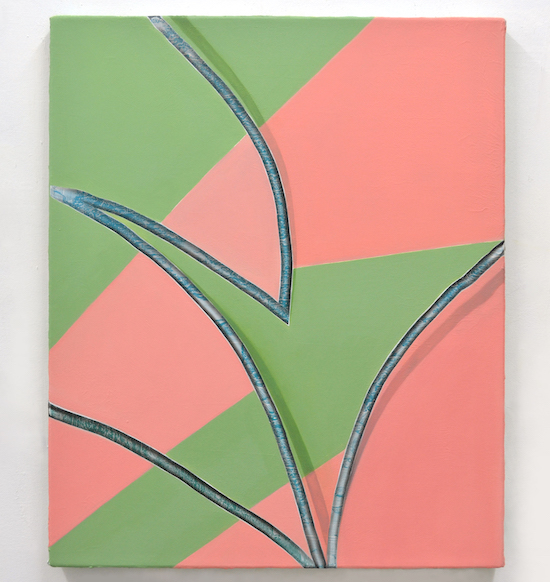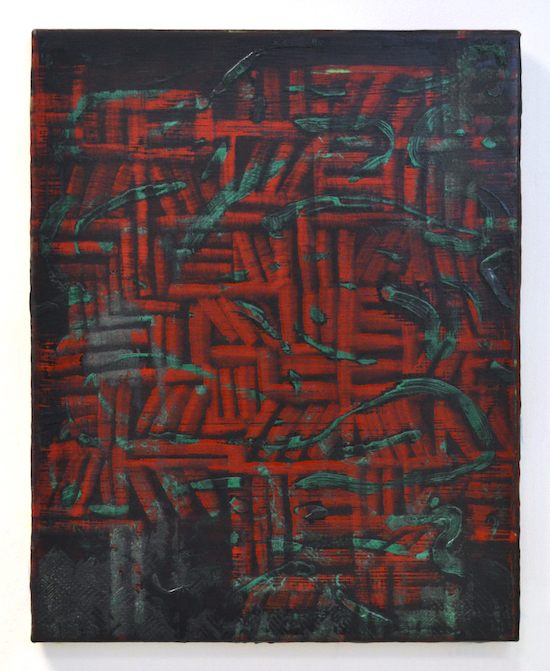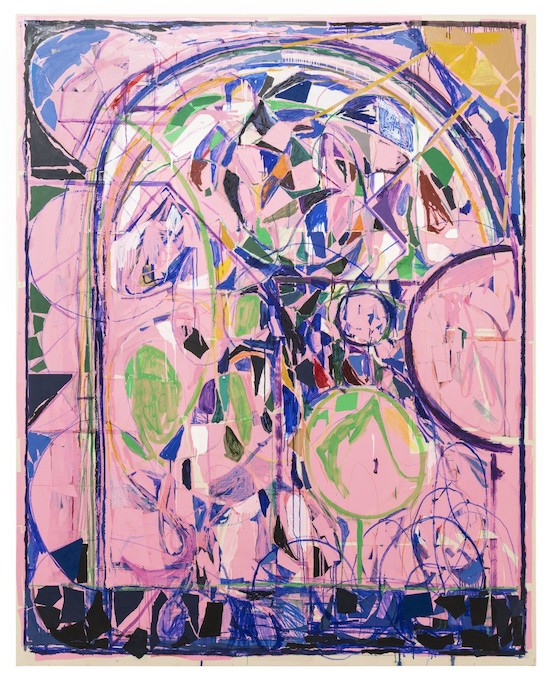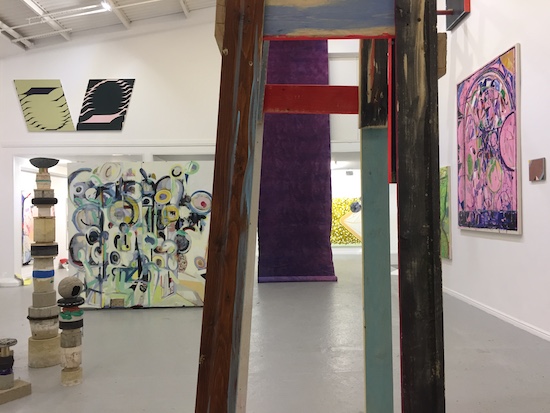London artists Howard Dyke and Mike Gittings take on South London’s 2,600 square foot Thames-Side Studio Gallery to present a selection of twenty-six abstract artists in the mammoth group exhibition, Modern Finance. Featuring the work of Adia Wahid, Martin Gayford, Sarah Woodburn, Ziggy Grudzinskas, and many others, Modern Finance styles itself as a collection of “unsettling voices from the other side of the water” weaned on “high rise debt on burnt out credit cards.” An artist-curator herself, Hannah Luxton finds out what inspires them to put down their paint brushes and assume the role of curator with this ambitious project.
Where is your art studio, and how does it look at this very moment?
Howard Dyke: At Loughborough Junction in a railway arch, and its covered wall to wall with new work.
Mike Gittings: I have a new studio at Deptford Foundry which I moved into a couple of months ago. The studio is run by Second Floor Studios & Arts who acquired a 250 year leasehold for 80, new, purpose built studio/workspaces incorporated within a development of new apartments. The studio is looking tidy at the moment but it goes through cycles. Messy, tidy, messy again!
What are some of the thoughts and ideas behind your painting practise? And what kind of processes do you use to explore these?
HD: My practice is varied and requires a physical element to make collaged paintings using bought and found materials, such as torn canvases and lorry tarpaulins. I’ll make interventions using reflective tape to draw lines and pour paint on the floor or from up a ladder. Through painting, cutting and displacing these elements, I get them to perform. The subject is based around the figure and mostly from imagery I’ve collected from the internet over the years. Often working to my physical limits, I am pushing for something new in painting.
MG: ‘playpaint’ began in 2008 as a collaboration between myself and Damian Nelson. We didn’t bring any personal or obvious aesthetic interests, or content to the project; the paintings were process led and generative and would begin from a very straightforward discussion or a simple trial. From these we could sufficiently anticipate the outcome and decide whether a painting was worth pursuing. Working solo since 2015, I input more complexity to this methodology, which expands the spectrum of possible outcomes.
Can you summarise the premise of the exhibition, Modern Finance, and how it got it’s name?
MG: We dispensed with the idea of a premise. We wanted to discover the exhibition rather than build it around a proposition. The title came about through a process of collaboration, but somehow seemed to come out of thin air.
HD: Modern Finance was just an idea to get people to show together who we felt would test each other’s limits in some way. The title came from a list of words we e-mailed back and forth. Mike put them together and that was the phrase that stood out. I like to think it’s a wry comment on us – the artists and our financial plight – but as we’re all different and I don’t know each other’s bank accounts I believe this to be untrue.

Two Or Three Graces Raymonde Beraud
I know a lot of artists who curate exhibitions, but don’t think we are that common. I think there is a certain type of artist that wants to curate to make things happen and bring artists together to say something. What are you so passionate about that inspired you to create Modern Finance?
MG: We liked the possibility of visual diversity and surprise on a massive scale. A collision of contradictory or connected aesthetic statements.
HD: We curate sometimes to build a context for each other to show work in. It’s a DIY attitude to make something of the situation other than to wait for someone to offer it to you. Saying that, we were offered the space, but we still had to come up with something good with what we could get our hands on at the time.
How long has Modern Finance been in the making?
MG: The first discussion about this was sometime last year, and Howard and I first met to begin organising the show in March 2019.
HD: Then only three days to install it !
Why Thames-Side Studios Gallery? Did its size as one of South London’s largest exhibition spaces have anything to do with it? Because you certainly maximised on that.
HD: Thames Side Studios kindly offered the space to us. I think they thought we could pull it off.
MG: Both Howard Dyke and playpaint have previously organised shows in the gallery. Howard had a solo show last year which he filled with immense paintings, and playpaint (with Damian Nelson) curated a painting show in 2015 with 90 artists called ‘Autocatalytic Future Games’. It is a rare opportunity to get to work with such a big space, which we couldn’t pass by.
With independent project spaces and galleries, the role of ‘curator’ often encompasses all the other work that’s involved in bringing an exhibition concept to life. Aside from the creative part, everything else from scheduling and logistics to admin and marketing demands a very different set of skills to those we develop at art school and as practising artists in the world. Is there anything you particularly excel at in this process?
HD: I think we are both are good at communicating with people and sharing our ideas. We gave everyone free reign to be as ambitious as they wanted as it is such a large space. We’ve both installed for galleries so we know what the logistics are.
MG: I’ve worked for many years as an art technician and managed many art projects. I’ve also worked outside the art world. These experiences probably exert more influence on what I do now than my art education, which seems by comparison both brief and remote. In some ways I would rather see the influence of acquired skills from admin experience and project management on the production of paintings than skills acquired at art school.

Arrangement In Red Raymonde Beraud
What was your biggest challenge with Modern Finance?
HD: The biggest challenge was meeting our challenge to create something we were proud of. There was no budget so everything had to be done with the recourses we had available. Everyone was helpful in bringing it together, like arranging their own transportation of works, which really helped. The next big challenge will be taking it down.
Did anything come about that you didn’t expect, any serendipitous moments, or situation where you surprised yourself?
MG: There were many serendipitous moments. The title ‘Modern Finance’ being one of them. Each time we resolved where an artist’s work would hang, it made us revise our idea of what the show was about. And looking back, now the show is complete, it’s hard to imagine removing a piece of work without the whole aesthetic balance collapsing.
What do you hope people will take away from the exhibition?
MG: I hope they feel the experience was time well spent.
HD: Hopefully people will take away some of the spirit of the show – and maybe a list of works.

Portrait (Pink) Dominic Kennedy
Do you have any other curatorial projects in the making?
HD: I co-run a space with another painter, Dominic Kennedy, called Ridgeway Road and we’re working on some ambitious ideas.
MG: playpaint is co-curating a two-person show with Julian Wakelin called ‘Optic Dub’ which is taking place in Deptford at no format Gallery in October.
Modern Finance is at Thames-Side Studio Gallery until 29 June. A curators’ talk will take place at the gallery on Sunday 16 June from 3pm


